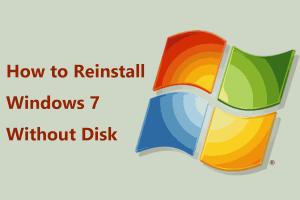Ultimate Guide to Reinstall Windows 7 Without CD: Step-by-Step Process

-
Quick Links:
- Introduction
- Why Reinstall Windows 7?
- Preparation Before Reinstallation
- Methods to Reinstall Windows 7 Without CD
- Method 1: USB Installation
- Method 2: Using Recovery Partition
- Method 3: Using Windows 7 Setup Files
- Common Issues and Solutions
- Expert Insights
- Conclusion
- FAQs
Introduction
Reinstalling Windows 7 can be a daunting task, especially if you don't have a CD. This guide will provide you with various methods to reinstall Windows 7 without the need for a CD, ensuring your computer runs smoothly once again.
Why Reinstall Windows 7?
Many users consider reinstalling Windows 7 for several reasons:
- Slow Performance: Over time, Windows can become sluggish due to accumulated files and programs.
- Viruses and Malware: Reinstalling can remove persistent malware that traditional antivirus software can't eliminate.
- System Errors: Frequent crashes and errors can often be resolved with a fresh installation.
- Upgrading Hardware: Sometimes, a clean install is necessary after upgrading your hardware.
Preparation Before Reinstallation
Before you start the reinstallation process, it's crucial to prepare your system:
- Backup Your Data: Ensure that all your important files are backed up to an external drive or cloud storage.
- Product Key: Ensure you have your Windows 7 product key ready.
- Drivers: Download necessary drivers for your hardware from the manufacturer's website.
- Power Supply: Ensure your computer is connected to a reliable power source to prevent interruptions during installation.
Methods to Reinstall Windows 7 Without CD
There are several effective methods to reinstall Windows 7 without using a CD. Here we will explore three primary methods:
Method 1: USB Installation
Using a USB drive is one of the easiest ways to reinstall Windows 7. Here’s how:
Step 1: Create a Bootable USB Drive
- Download the Windows 7 ISO file from a reputable source.
- Use a tool like Rufus or Windows USB/DVD Download Tool to create a bootable USB drive.
Step 2: Boot from USB Drive
- Insert the bootable USB drive into your computer.
- Restart your computer and enter the BIOS/UEFI settings (usually by pressing F2, F10, DEL, or ESC).
- Change the boot order to prioritize the USB drive.
Step 3: Start Installation
- Save changes and exit BIOS.
- Your computer will boot from the USB drive, and the Windows installation process will begin.
- Follow the on-screen prompts to complete the installation.
Method 2: Using Recovery Partition
Most Windows 7 laptops and desktops come with a recovery partition that allows you to restore the system to factory settings.
Step 1: Access Recovery Partition
- Restart your computer and press the designated key for recovery (usually F8 or F11).
- Select "Repair Your Computer" from the Advanced Boot Options menu.
Step 2: Follow the Recovery Process
- Choose your keyboard layout and click "Next."
- Select your operating system and click "Next."
- Follow the prompts to restore your computer to factory settings.
Method 3: Using Windows 7 Setup Files
If you’ve previously downloaded Windows 7 setup files, you can reinstall directly from your hard drive.
Step 1: Locate Setup Files
Ensure the Windows 7 setup files are in a folder on your hard drive, preferably on the C:\ drive.
Step 2: Execute Setup
- Double-click on the setup.exe file to start the installation process.
- Follow the on-screen instructions to reinstall Windows 7.
Common Issues and Solutions
While reinstalling Windows 7, you might face some common issues. Here are solutions to tackle them:
- Boot Device Not Found: Ensure your USB drive is properly created and plugged in.
- Installation Freezes: Check if your USB drive is corrupted or faulty.
- Missing Drivers: Download and install drivers from the manufacturer’s website before starting the installation.
Expert Insights
According to industry experts, reinstalling your operating system can significantly boost performance and eliminate persistent bugs. Regular maintenance and updates can also prolong the need for reinstallation.
Conclusion
Reinstalling Windows 7 without a CD is not only feasible but also straightforward when following the methods outlined above. Whether using a USB drive or a recovery partition, you can restore your system to optimal performance with ease. Always remember to back up your data before proceeding with any installation process.
FAQs
1. Can I reinstall Windows 7 without losing my files?
Yes, you can choose to keep your files during the installation process by selecting the appropriate option.
2. What should I do if I don’t have a product key?
You may need to purchase a new license from Microsoft or a trusted retailer.
3. Is it possible to install Windows 7 on a new hard drive?
Yes, you can install Windows 7 on a new hard drive using a bootable USB or recovery partition.
4. How long does the installation process take?
The installation process typically takes 30 minutes to an hour, depending on your hardware.
5. What if my computer doesn't boot from the USB drive?
Make sure the USB is properly formatted and set as the primary boot device in BIOS settings.
6. Can I reinstall Windows 7 multiple times?
Yes, you can reinstall Windows 7 as many times as you need, as long as you have a valid product key.
7. Do I need to reinstall drivers after reinstalling Windows 7?
Yes, you may need to reinstall drivers for your hardware after completing the Windows installation.
8. What happens to my installed applications during reinstallation?
If you choose to format the drive, all applications will be removed. If you keep files, some applications may remain, but it’s advisable to reinstall them.
9. Is internet access required for installation?
No, you can install Windows 7 without internet access, but you may need it later to download updates and drivers.
10. How can I ensure a successful installation?
Follow the steps carefully, use a reliable USB drive, and ensure all backups are complete before starting the process.